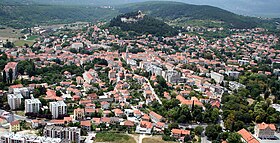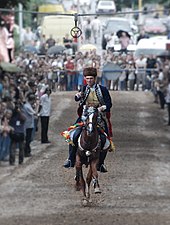Sinj
Sinj | |
|---|---|
| Grad Sinj Town of Sinj | |
 Aerial view of Sinj | |
 | |
| Coordinates: 43°42′9″N 16°38′17″E / 43.70250°N 16.63806°E | |
| Country | |
| Historical region | Dalmatia |
| County | |
| Government | |
| • Type | Mayor-Council |
| • Mayor | Miro Bulj (Most) |
| • Town Council | 21 members |
| Area UTC+2 (CEST) | |
| Postal code | 21230 |
| Area code | +385 021 |
| Vehicle registration | ST |
| Website | sinj |
Sinj (Croatian:
Sinj is known for a knights' tournament of Sinjska alka,[3] which has been held since the beginning of the 18th century as a sign of victory over the Ottoman invaders, and for the shrine of Our Lady of Sinj. The urban center of Sinj is a protected cultural heritage site.[4]
Geography

Sinj is located in
History
Prehistory
Several stone weapons and tools discovered in Cetinska Krajina attest to the area's population dating back to the Mesolithic.[5][6] Many caves and dugouts contain evidence of later Neolithic settlements. About 1000 years BC, the area was inhabited by the Illyrian tribe Dalmatae. They were settled in the area between the rivers of Krka and Cetina, where they clashed with the Romans in the period of wars from 156 BC to 9 AD, ending with their complete defeat under the leadership of Bato the Daesitiate.[5]
Roman era
In Roman times, there were two important localities in the vicinity of Sinj: Colonia Claudia Aequum near today's village of Čitluk, and Tilurium, today's Gardun near Trilj.
Aequum was probably founded by
During the long period of peace (Pax Romana), the Romans built roads in the area, fortified Osinium (Sinj), on Illyrian foundations, and Tilurium on the southernmost edge of the polje of Sinj; they built a bridge on Cetina (Pons Tilurii) and numerous villa rusticas.[5] Tilurium was once home to the Roman 7th legion, followed by Roman auxiliary units.
Since the fall of the Western Roman Empire in 476, the Cetina region had been ruled by the Byzantine Empire.
Arrival of Croats

It is unknown when the Croats settled in the area. The Byzantine Emperor Constantine VII mentions the Cetina County among the Croatian administrative units in his 10th century work De Administrando Imperio.
Over time, a settlement developed beneath the old fortress, which was referred to as Cetina after the nearby river, but the name of the old town Sinj was eventually transferred to it, and it remains so to this day. Following the extinction of the Trpimirović dynasty in 1102, the country was united with Hungary under the Árpád dynasty, but Cetina was ruled almost independently by the Domaldo family, then by the powerful Croatian Šubić family from the end of the 13th century, falling under the rule of the Nelipić family in the middle of the 14th century. It was ruled by the Talovci family beginning in the middle of the 15th century, followed by general discord and internal conflicts until it fell to the Ottoman Turks.[5]
Ottoman and Venetian era
In 1513[

With the return of power of the
Due to harsh living conditions and constant oppression under Ottoman rule, the domicile population declined, so Venetian authorities attempted to attract people from western Bosnia. The most massive migration took place in 1687, led by the
Following the
Austrian and French rule
The Republic of Venice and its possessions were abolished by the agreement between Napoleon and Holy Roman Empire (Austria) on October 17, 1797. Napoleon ceded the Venetian possessions to Austria, and in July the first Austrian troops arrived in Cetinska Krajina. This marked the beginning of the first Austrian occupation of Dalmatia, which would last for eight years. As a result of new Austrian policies, Sinj's first public elementary school opened in 1798.[5]
With the defeat in the Battle of Austerlitz in 1805, Austria was forced to hand over all former Venetian possessions to Napoleon, giving the region a new master at the beginning of 1806. A tumultuous and significant period of French rule began that would last seven years. In 1811, the French established the Municipality of Sinj. The French administration canceled state subsidies wherever it was possible, thus canceling the support for Alka. Following Napoleon's defeat in Russia and near Leipzig in 1813, the Austrian army reoccupied Dalmatia, and Sinj. After the
To get to know the newly acquired properties, Austrian Emperor Francis II takes a journey through Dalmatia in 1818, and visits Sinj. The people of Sinj use the opportunity to organize the tournament of Alka, which Francis II liked so much that he established a permanent annual financial support.
Despite
Kingdom of Serbs, Croats, and Slovenes

After the defeat of Austria in WWI, a new union was created in 1918, the
The city center was first electrified around 1922.[5]
Second World War
The town and nearby settlements were under the rule of military forces of the Independent State of Croatia, Italian, and German armies. This resulted in the spread of the idea of
On October 25, 1944, the town was liberated by the forces of the 20th Division of the Yugoslav Army.[12]
During the war, 479 residents of the Sinj region were interned in concentration camps, the majority of whom never returned.[12] On April 22, 1945, Ante Bakotić from Sinj led the escape of male prisoners from the Jasenovac Concentration Camp, shortly before the end of WWII. Many of the 1,073 detainees at the time, including Bakotić, did not survive the flight.
Socialist Republic of Croatia
Following WWII, there was extensive work to increase
The city was rapidly expanding through planned construction, which began with housing for workers at the newly established megafactory Dalmatinka; the town's Olympic swimming pool was built in parallel with the building of the factory.[14][16][8] Sinjski skojevci Elementary School opened (in 1977), as well as with a new large sports hall, a hotel, a hippodrome for the 1979 Mediterranean Games, and a large high school building. The construction of the Split-Zagreb state road (1963) improves traffic connections,[13] but the narrow-gauge railway known as Sinjska rera, which connected the town to Split, was discontinued in 1962.
Independent Croatia

Since the summer of 1991, a large part of the old Municipality of Sinj was occupied, and Sinj was within artillery range of the rebel Serbs' positions, about 6 km away; some 3,000 shells were fired at the city.[5] Along with the rest of Dalmatia, Sinj was cut off from the motherland in terms of transportation and energy.
In modern Croatia, Sinj has regressed economically: industry from the socialist period either collapsed or was destroyed by war and tycoon privatization during the war.[13] Most of the economy consists of service activities. The city promotes the development of agriculture, transport, tourism, and industry, so far with limited success.[13][17]
Demographics
As of the 2021 census, the total population of the municipality was 23 452, distributed across the following
- Bajagić, population 496
- Brnaze, population 3 124
- Čitluk, population 462
- Glavice, population 3 597
- Gljev, population 225
- Jasensko, population 306
- Karakašica, population 682
- Lučane, population 601
- Obrovac Sinjski, population 794
- Radošić, population 681
- Sinj, population 10 771
- Suhač, population 577
- Turjaci, population 1 014
- Zelovo, population 122
| population | 7600 | 8256 | 9025 | 10089 | 11543 | 13205 | 13770 | 14829 | 15526 | 16864 | 18687 | 20598 | 23849 | 25985 | 25373 | 24826 | 23452 |
| 1857 | 1869 | 1880 | 1890 | 1900 | 1910 | 1921 | 1931 | 1948 | 1953 | 1961 | 1971 | 1981 | 1991 | 2001 | 2011 | 2021 |
Attractions

Sinj is well-known for
Sinj is home to the Museum of the Cetinska Krajina Region,[19] Museum of Alka,[20] Archaeological Collection of the Franciscan Monastery,[21] and two galleries.
Twin towns and sister cities
Sinj is
 Montemarciano, Italy
Montemarciano, Italy Sansepolcro, Italy
Sansepolcro, Italy Barban, Croatia
Barban, Croatia Đakovo, Croatia
Đakovo, Croatia
 Vukovar, Croatia
Vukovar, Croatia Šibenik, Croatia
Šibenik, Croatia Trogir, Croatia
Trogir, Croatia Prozor-Rama, Bosnia and Herzegovina
Prozor-Rama, Bosnia and Herzegovina Prnjavor, Bosnia and Herzegovina
Prnjavor, Bosnia and Herzegovina
References
- Wikidata Q119585703.
- ^ "Population by Age and Sex, by Settlements, 2021 Census". Census of Population, Households and Dwellings in 2021. Zagreb: Croatian Bureau of Statistics. 2022.
- ^ a b "Sinjska Alka, a knights' tournament in Sinj". UNESCO Intangible Cultural Heritage. Retrieved 2024-03-22.
- ^ "Kulturno-povijesna urbanistička cjelina Sinja". Registar kulturnih dobara Republike Hrvatske (in Croatian). Retrieved 2024-03-22.
- ^ ISBN 953-98209-9-5.
- ^ Borković, Velimir (1982). "Historijsko - geografske osnove naseljavanja Cetine". Hrvatski geografski glasnik. 44 (1): 69–84.
- ^ . Retrieved 8 May 2017.
- ^ a b c "History". www.visitsinj.hr. Retrieved 2024-03-22.
- ^ Marković, Ivan (1898). Sinj in njegovo slavlje, god. 1887: spomen knjiga (in Croatian). Dionička tisk.
- ^ Die postalischen Abstempelungen auf den österreichischen Postwertzeichen-Ausgaben 1867, 1883 und 1890, Wilhelm KLEIN, 1967
- ^ Perić, Marinko (1974). Sinj i Cetinska krajina u borbi za slobodu. Sinj: Turističko društvo Cetinska krajina : Turist biro Alkar.
- ^ ISBN 86-7397-073-3.
- ^ a b c d Paštar, Toni (2021-09-09). "Radnice su plakale dok su im rušili tvornice: sinjska 'Dalmatinka' nekad je zapošljavala 2650 radnika, 'Cetinka' 1100, IGRO 'Sinj' 450, 'Konkurent' 400, 'Sinjanka' 330..." (in Croatian). Slobodna Dalmacija. Retrieved 2024-03-21.
- ^ ISSN 0547-2504.
- ^ "Glazbena škola Jakova Gotovca u Sinju". Archived from the original on 23 August 2017. Retrieved 22 May 2020.
- ^ "Dalmatinka". Hrvatska tehnička enciklopedija (in Croatian). 2020-03-13. Retrieved 2024-03-22.
- ^ Paštar, Toni (2021-04-29). "Kako su sve sinjske vlasti dosad više uništavale nego unaprjeđivale centar Cetinske krajine: ovo je 11 neuralgičnih točaka u alkarskom gradu" (in Croatian). Slobodna Dalmacija. Retrieved 2024-03-21.
- ^ "Population by Age and Sex, by Settlements, 2011 Census: Sinj". Census of Population, Households and Dwellings 2011. Zagreb: Croatian Bureau of Statistics. December 2012.
- ^ "Museum of the Cetinska Krajina Region". www.visitsinj.hr. Retrieved 2024-03-22.
- ^ "Museum Alka of Sinj". www.visitsinj.hr. Retrieved 2024-03-22.
- ^ "Archaeological Collection of the Sinj Franciscan Monastery". www.visitsinj.hr. Retrieved 2024-03-22.






